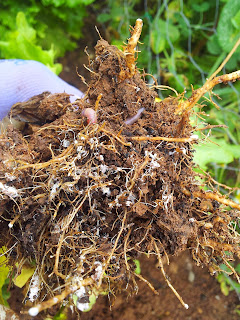 |
| empire of towering lettuce |
Mind you having too much lettuce is generally a good thing, the slugs and flea beetles appreciate the excess and you don't have a conniption when you discover a few plants have vanished overnight.Not an invitation rabbits, if ye are reading this.
Lettuce that goes unmolested ends up in towers, tall formidable plants with only one goal to flower and set seed as quickly as possible. Far be it for me to deny their biological destiny but lettuce towers are no good for eating, the leaves become quite bitter and a hell of a lot tougher than you would like.Besides the mid-summer squeeze is on for space, winter crops are now nice sized seedlings that need to get transplanted outdoors,so anything that has ceased being productive has got to go.
 |
| the white stuff |
One wheelbarrow later the bed was emptied of it's lettuce towers and the weeds pulled to clear the ground for the new arrivals. On the west side I'm putting in (yet another) pumpkin plant while on the east side, lying very much in shade after midday, I'm putting in mizuna and mibuna, members of the rocket family that make very tasty salad greens but bolt quickly in too hot conditions. Although the bed was originally well fed with a whole compost heap I did put some pelleted chicken manure down to keep them going while their roots establish themselves within the network of fungi and bacteria in the soil. You might have noticed this period yourself when you transplant out into the garden- plants just sit there for a few weeks before they start to really get going.
 |
| Broad beans tower over the bed |
Casting all the shade over the bed are the Oldambaster broad beans which have now reached and pushed beyond the height of the lettuce wire supporting the peas and mange tout. Later planted varieties of broad beans are in no way so prolific and bountiful-the crop is just outstanding. Despite giving away a big pile to Dace last weekend we could feed half the parish with what remains. They are definitely one of the success stories of this veg year.
The poor french beans have not been so lucky. They did recover from the root chewing they got just as I transplanted them out and have now begun to slowly flower but they are small weak plants and I don't really expect much of a bounty from them at this stage.
In went the salad crops. Although I bought a bag of sluggone I decided not to use it on this bed. My poor slugs would be too confused, they are not used to no-go areas in the garden. I might arrive the next morning to find them all out protesting with plac cards! I'm saving the slug gone for more troublesome areas and smaller amounts of plants, after all I do have lots of salad crops, enough for all of us.
 | |
| Oldambaster broad bean crop |
No comments:
Post a Comment